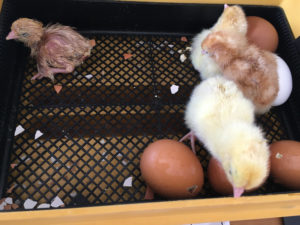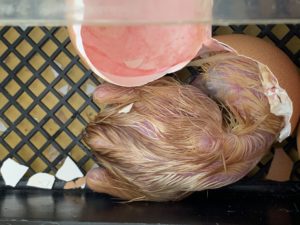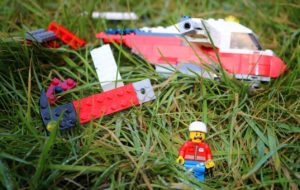Chicks
At the time of writing this post, we have 4 chicks (2 yellow and 2 brown) that have hatched and 3 eggs that have little cracks in their shells. The fluffy chicks hatched earlier, their feathers have had time to dry in the incubator. The little chick in the corner only hatched 30 minutes ago. Its feathers are still wet and it’s lying down, resting.

We hope that you’ve enjoyed watching the videos so far. In the next video, we managed to film the little chick (in the corner of the photograph) just as it was about to hatch. It’s a time-lapse video so it appears to happen much quicker than it does in real life. Apologies for the wobbles, Mrs Long was videoing for about 20 minutes or more! It’s quite tricky to see clearly, but you might be able to see that the chick is pecking around the shell to crack it more and more. Each time it pecks, it has a little rest before starting again.
Here’s a photograph of the chick, taken just after the video stopped. Can you see its eye and legs? What colour feathers does it have?


What shall we call our chicks?
Send us an e-mail with your suggestions for names and don’t forget to tell us how you’re getting on with your learning from home. Did you read or watch ‘Oh Dear!’ today? Ferdie, our Nursery fox, has come to live with Mrs Long whilst we’re not at Nursery. He’s been busy today; he read ‘Oh Dear!’ this morning and he enjoyed taking part in a PE session with Joe Wick. He also counted how many chicks have hatched and counted how many eggs are left!

Chicks beginning to hatch…
We have been checking the incubator for the last few hours and the cracks in some of our eggs are getting bigger. It’s fascinating to watch; you can see the chick pecking from the inside, trying to get out!
We’ll add the videos and photos of our hatched chicks soon. We’re busy editing them!
Egg-citing news!
Mrs Latham has been looking after Foundation 2’s chicks. This morning one egg began to crack and…


How exciting! We will keep you updated with more chick news.
Can your child talk to you about the life cycle of a chicken? We have been talking lots about the life cycle of a chicken in the classroom.
We can see a crack…
How exciting! Last night, just before bedtime Mrs Long noticed a crack had appeared in some of our eggs.


We’ve taken the incubator off the rocker now, to keep the eggs still.
What happens when the eggs hatch?
After growing for about three weeks, the chicks inside are ready to break out of their shells. This is called hatching. The chick has a special ‘egg-tooth’ on its beak which it uses to crack a hole in the shell. If you listen very carefully on the video, you’ll be able to hear the chicks chirping inside.
Talk to your child about what happens as the chick hatches; they may remember talking about it during group time at Nursery. Over the next few hours, the chicks will gradually chip away around the inside of the shell until it has broken it enough to get out.
Remember to check the website again soon to see the first our chicks hatch!
23 March 2020: Home learning
Day 1 of your home learning pack
Phonics
Was your child able to blend the four daily words today? Your child could use their ‘phoneme fingers’ (see video) to help them when reading words. A phoneme is a unit of sound. So when sounding out words with digraphs/trigraphs those 2/3 letters is one unit of sound. For example; chip is sounded out as ch/i/p – using 3 fingers.
Maths
What objects did you use when finding one less? Was your child able to predict without counting?
Literacy
We loved this photo on pobble365. We think the mischievous splodges might be something to do with this crash! Perhaps Wiz and the Writing Warriors can save the day?

Did your child have a favourite picture? Did your child make up their own story? Let us know via email. With each photo there are story starters and questions to help encourage your child’s imagination.
If you have any questions we are here to help and will respond to emails during school hours: scholesf2@spherefederation.org
Oh Dear
This week we will be thinking about the story Oh dear by Rod Campbell. He also wrote the story Dear Zoo, maybe you would like to listen to that too.
You might have this story at home but if not, follow the link to it on YouTube. We have chosen this story because this week, we are hoping that our eggs will hatch. Mrs Long has taken them home, so no need to worry. She will be keeping us updated with photos via the website as they are due to hatch on Wednesday, fingers crossed. It is such a shame that the children will not see them hatch first hand, but hopefully they will be excited to see their progress.
Read or listen to the story with your child – talk about the story with your child. Discuss all of the animals that Buster visits on the farm. Talk about the young of these animals and their names eg sheep – lamb, a horse- foal. Listen to the story again encouraging your child to join in with the repeated phrase “No eggs here, Oh dear”. How many eggs can they see in the nest at the end of the story? How many animals are in the story?
Here are some activities that you can try that are linked to the story.
Can you draw a chick? Perhaps draw the basic outline of 2 circles then ask your child to add a beak, eyes, legs, wings, feathers.
Small world play – If you have farm animals at a home ask your child to set up their own farm. Use paper for fields and an old cereal box as a farm house.
Sing – Old MacDonald and Baa baa black sheep are favourites in Nursery. Why not learn Chick chick chicken ? Folow the link to listen and sing along together.
Watch – Keep an eye on the website for photos of our chicks. Talk to your child about what they see in the pictures. Why are the chicks wet when they hatch? Why do they need to stay in the incubator?
Eggs – We were planning to look at eggs in various forms at Nursery. Maybe you could do this at home? Peeling a boiled egg is a finger strengthening activity that young children need in order to develop the muscles needed to write. Let them help to make an egg sandwich.
Extra resources and ideas – As detailed in the ‘Useful websites for Home Learning‘ document, Twinkl is offering free access for a month to parents using the code UKTWINKLHELPS. There are a number of chick themed resources available to download and print if you have a printer at home. We often use the pencil control activities and colouring outlines in Nursery.
Let us know how you get on by replying to the email address scholesf1@spherefederation.org. We would love to hear about what you have been doing. Also we are happy to answer any of your questions too.
Have fun!
Home learning explained
Home Learning – further details
Email for home learning support
Please email if you’re unsure about some aspects of the home learning. We are here to support you and your child’s home learning journey.
The Early Years email address is scholesf2@spherefederation.org
We’ll aim to reply on the same day and no later than the following morning. To keep this manageable, please restrict emails to one per day, per child.
PE with Joe Wicks
Some classes have used Joe Wicks workouts in their PE lessons recently and he has sent a message for you all.
Starting Monday 23rd March I’m going to be hosting a free workout aimed at kids LIVE on my YouTube channel.
With the schools closed and with us all spending more time at home, it’s more important than ever that we keep moving and stay healthy and positive.
Exercise is an amazing tool to help us feel happier, more energised, and more optimistic.
The workouts will be fun and suitable for all ages and even adults can get involved.
You don’t need any equipment, just tune in to my YouTube channel at 9am each morning for a 30-minute, fun workout.
One more thing! I really need your help to spread this message. So please please share this with everyone that might like to get involved, and together we can help keep the nation moving
🏻
